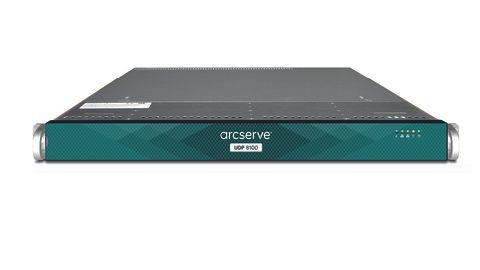IT Pro Verdict
At more than £10,000, the Arcserve 8100 isn't a budget option, but its credentials are beyond reproach. It's easy to deploy and provides top-notch data protection features.
Pros
- +
Simple setup; Impressive data compression;
Cons
- -
Expensive
If you're a medium-sized business with big backup requirements, Arcserve's UDP appliances could be perfect. They provide a one-stop shop for backup and recovery of physical and virtual environments. As standard, they include replication, high availability and space-saving deduplication technologies.
The latest UDP 8000-series appliances also offer a wide range of capacities; the entry-level 8100 model starts with 4TB of backup storage, courtesy of three 2TB SAS3 hard disks in a RAID5 array. This is managed by an Avago SAS RAID card, while a 120GB Intel SATA SSD handles UDP's deduplication hash tables. There's also a fourth drive bay for expansion.
As the price implies, this is no lightweight backup unit. It's powered by a six-core Xeon E5-2609 v4, with 64GB of DDR4 memory and dual gigabit data ports. Here, too, there's room to grow via optional 10GbE upgrades. The 8100 is supplied with Windows Server 2012 R2 Standard and the Arcserve UDP software preinstalled. After attaching a local monitor, mouse and keyboard, we were able to follow the quick start wizard to join the appliance to our domain, add member nodes and create a protection plan in 20 minutes. All declared nodes have the agent automatically pushed to them, taking around ten minutes for each one.
A key feature of the Arcserve package is its recovery point server (RPS), which defines data stores on the appliance where data is backed up to. Plans define the number of recovery points required, with schedules for full and incremental backups that can be run every 15 minutes. You can add tasks to a plan, with options that include remote RPS replication, file copying and, if you've loaded the Arcserve Backup software, migrating data to a tape drive attached to an optional SAS host bus adapter.
Another feature is Virtual Standby, which uses recovery points to create local VMware or Hyper-V VMs of selected nodes. The VM is kept up to date with the latest data so, if the primary node goes down, the standby VM is fired up to provide continuity.
There's also a new Instant VM feature, which creates on-demand VMs from node recovery points. This is impressively quick: we set it to create a new Hyper-V VM from our latest Exchange 2013 backup and had it ready to boot in 30 seconds.
Alongside D2D and D2D2T migration strategies, UDP supports the Arcserve Cloud service. Coming in 3TB, 6TB or 9TB annual subscriptions, this allows data to be replicated off-site and provides cloud-based Virtual Standby for disaster recovery.
When it comes to restoring data, the Arcserve is flexible. You can load the agent interface from the UDP console or locally at the client, browse recovery points, select drives and folders and choose where to restore them. SQL databases are as easy to restore as individual files, and the 8100 can even make entire data stores available as network shares.
The only part that required more legwork was granular recovery for Exchange. We accessed our Exchange agent and mounted the latest restore point as a new drive on the UDP server. After loading the GRT restore utility and pointing it at the Exchange backup, we could then browse our users, view mailbox contents, connect the utility to our live Exchange server and restore individual items.
For agent-based backups, UDP performs deduplication both locally at the source and globally on the RPS data store. We were impressed by its data reduction efficacy: we backed up 615GB of data, which deduplication and compression scrunched down to only 216GB.
At more than 10,000, the Arcserve 8100 isn't a budget option, but its credentials are beyond reproach. It's easy to deploy and provides top-notch data protection features.
Verdict
At more than £10,000, the Arcserve 8100 isn't a budget option, but its credentials are beyond reproach. It's easy to deploy and provides top-notch data protection features.
1U rack server
1.7GHz Intel Xeon E5-2609 v4
64GB DDR4 (max 160GB)
Avago SAS 9361-4i PCI-E RAID
3 x 2TB Seagate Enterprise SAS3 hot-swap drives in RAID5 array (max 4)
120GB Intel SATA SSD
2 x Gigabit Ethernet
2 x 500W hot-plug PSUs
3yr hardware warranty
Dave is an IT consultant and freelance journalist specialising in hands-on reviews of computer networking products covering all market sectors from small businesses to enterprises. Founder of Binary Testing Ltd – the UK’s premier independent network testing laboratory - Dave has over 45 years of experience in the IT industry.
Dave has produced many thousands of in-depth business networking product reviews from his lab which have been reproduced globally. Writing for ITPro and its sister title, PC Pro, he covers all areas of business IT infrastructure, including servers, storage, network security, data protection, cloud, infrastructure and services.



